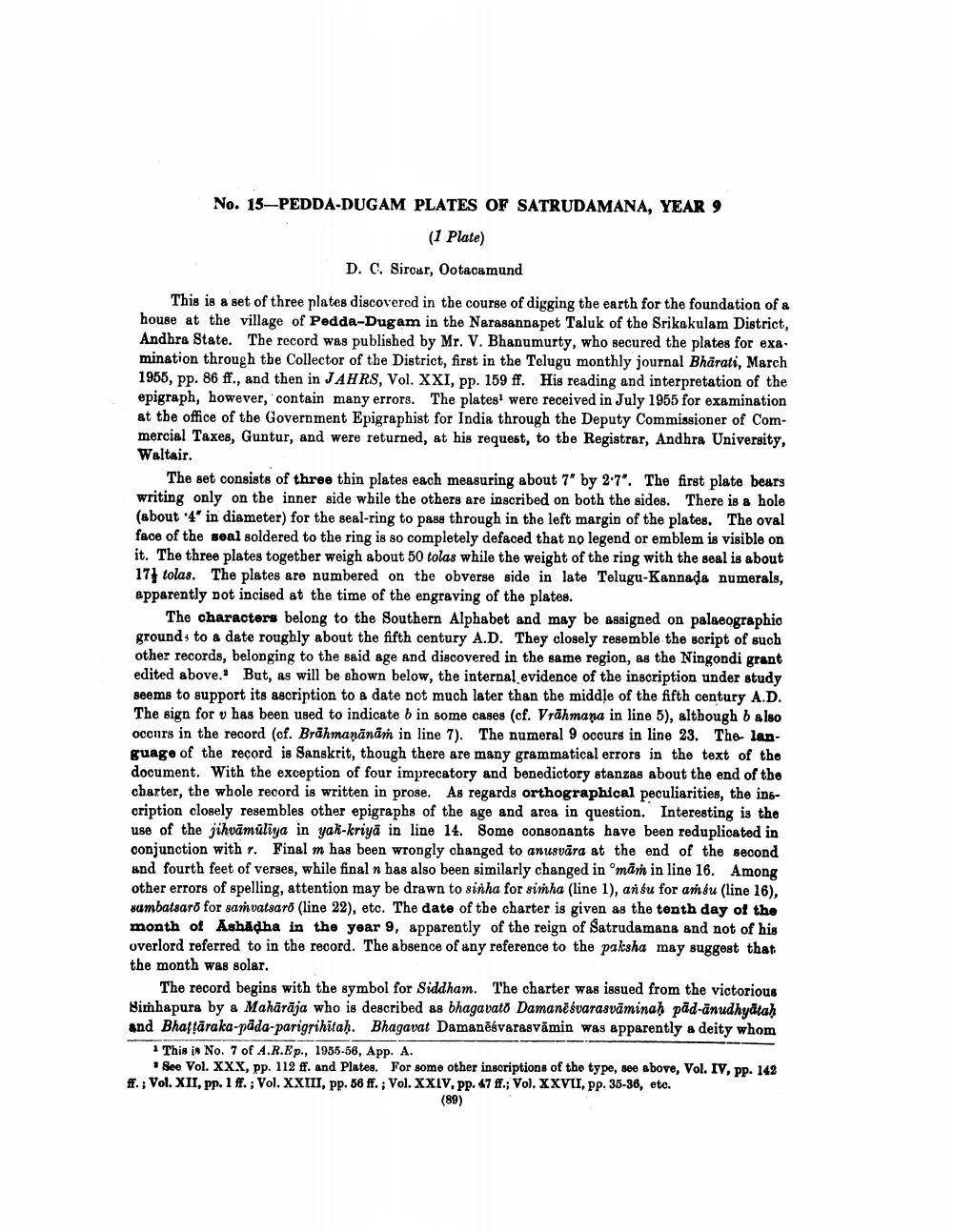________________
No. 15–PEDDA-DUGAM PLATES OF SATRUDAMANA, YEAR 9
(1 Plate) D. C. Sircar, Ootacamund
This is a set of three plates discovered in the course of digging the earth for the foundation of a house at the village of Podda-Dugam in the Narasannapet Taluk of the Srikakulam District, Andhra State. The record was published by Mr. V. Bhanumurty, who secured the plates for exa mination through the Collector of the District, first in the Telugu monthly journal Bharati, March 1955, pp. 86 ff., and then in JAHRS, Vol. XXI, pp. 159 ff. His reading and interpretation of the epigraph, however, contain many errors. The plates were received in July 1955 for examination at the office of the Government Epigraphist for India through the Deputy Commissioner of Commercial Taxes, Guntur, and were returned, at his request, to the Registrar, Andhra University, Waltair.
The set consists of three thin plates each measuring about 7" by 2.7". The first plate bears writing only on the inner side while the others are inscribed on both the sides. There is a hole (about 4' in diameter) for the seal-ring to pass through in the left margin of the plates. The oval face of the soal soldered to the ring is so completely defaced that no legend or emblem is visible on it. The three plates together weigh about 50 tolas while the weight of the ring with the seal is about 17 tolas. The plates are numbered on the obverse side in late Telugu-Kannada numerals, apparently pot incised at the time of the engraving of the plates.
The characters belong to the Southern Alphabet and may be assigned on palaeographic ground: to a date roughly about the fifth century A.D. They closely resemble the script of such other records, belonging to the said age and discovered in the same region, as the Ningondi grant edited above. But, as will be shown below, the internal evidence of the inscription under study seems to support its ascription to a date not much later than the middle of the fifth century A.D. The sign for v has been used to indicate b in some cases (cf. Vrāhmana in line 5), although b also occurs in the record (cf. Brāhmanānām in line 7). The numeral 9 occurs in line 23. The language of the record is Sanskrit, though there are many grammatical errors in the text of the document. With the exoeption of four imprecatory and benedictory stanzas about the end of the charter, the whole record is written in prose. As regards orthographical peculiarities, the inscription closely resembles other epigraphs of the age and area in question. Interesting is the use of the jihvāmuliya in yak-kriya in line 14. Some consonants have been reduplicated in conjunction with 1. Final m has been wrongly changed to anusvāra at the end of the second and fourth feet of verses, while final n has also been similarly changed in Omām in line 16. Among other errors of spelling, attention may be drawn to sinha for simha (line 1), an su for ansu (line 16). sambatsarð for samvatsarð (line 22), etc. The date of the charter is given as the tenth day of the month of Ashadha in the year 9, apparently of the reign of Satrudamana and not of his overlord referred to in the record. The absence of any reference to the paksha may suggest that the month was solar.
The record begins with the symbol for Siddham. The charter was issued from the victorious Himhapura by a Maharaja who is described as bhagavató Damanesvarasväminah päd-änudhydrah and Bhattāraka-pada-parigrihitah. Bhagavat Damanēsvarasvamin was apparently a deity whom
1 This is No. 7 of A.R.Ep., 1955-56, App. A.
• Soe Vol. XXX, pp. 112 ff. and Plates. For some other inscriptions of the type, see above, Vol. IV, pp. 142 ff.; Vol. XII, pp. 1 ff.; Vol. XXIII, pp. 66 ff.; Vol. XXIV, pp. 47 ff.; Vol. XXVII, PP. 35-36, etc.
(89)




